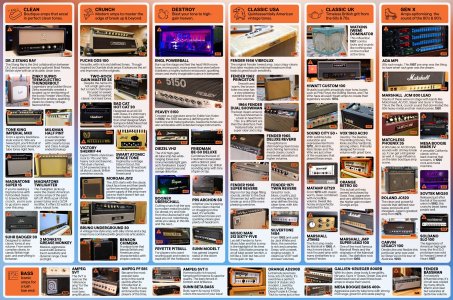I really like this unit because of the well-curated 56 amps many of which I dig. I also like that the tone-stack is apparently modeled which is different from other NAM players. But I'm ultimately puzzled by the tones coming out of this thing. Here are all 56 amps demoed -
I know Pete doesn't use too much gain but he is hitting the strings pretty hard on some of this and there's hardly any breakup (listen to Marshall JMP at 12:45 for example). So that brings me to some of the settings - the 'Volume' is a post amp volume increase. So the 'Gain' and 'Boost' knobs are what drive the amp. The 'Boost' knob is apparently the exact same thing as the 'Gain' knob, but just separated out so you can hit that programmed boost level for increase in gain for leads etc.
At the nominal 'Gain' level seen in most of the demos, there doesn't seem to be much amp gain, especially on the heavier amps. Bumping the gain knob helps a lot as seen in some of the other pedal demo videos (like Shawn Tubbs') - but that has me puzzled about what actual amp gain level the profile was captured to begin with, and how that value correlates to the 'Gain' setting on the Ample.
Reminds me almost of the situation when playing plugin amp models and deciding what level to set the audio interface gain level at. Yes, I understand that I can just set things to taste...but, I'm interested in knowing what the right 'Gain' level to use is to replicate how the profile was captured.
Which brings another question - if the profile was captured at very low gain levels, for whatever reason - this being a capture - how does that translate when you play at a far higher gain level? Obviously, there is a level of gain for which the results are still representative of the amp character. But I'm thinking that past a certain gain level, your results are no longer fully accurate and you'd be 'extrapolating' so to speak.
Any thoughts?
I know Pete doesn't use too much gain but he is hitting the strings pretty hard on some of this and there's hardly any breakup (listen to Marshall JMP at 12:45 for example). So that brings me to some of the settings - the 'Volume' is a post amp volume increase. So the 'Gain' and 'Boost' knobs are what drive the amp. The 'Boost' knob is apparently the exact same thing as the 'Gain' knob, but just separated out so you can hit that programmed boost level for increase in gain for leads etc.
At the nominal 'Gain' level seen in most of the demos, there doesn't seem to be much amp gain, especially on the heavier amps. Bumping the gain knob helps a lot as seen in some of the other pedal demo videos (like Shawn Tubbs') - but that has me puzzled about what actual amp gain level the profile was captured to begin with, and how that value correlates to the 'Gain' setting on the Ample.
Reminds me almost of the situation when playing plugin amp models and deciding what level to set the audio interface gain level at. Yes, I understand that I can just set things to taste...but, I'm interested in knowing what the right 'Gain' level to use is to replicate how the profile was captured.
Which brings another question - if the profile was captured at very low gain levels, for whatever reason - this being a capture - how does that translate when you play at a far higher gain level? Obviously, there is a level of gain for which the results are still representative of the amp character. But I'm thinking that past a certain gain level, your results are no longer fully accurate and you'd be 'extrapolating' so to speak.
Any thoughts?

